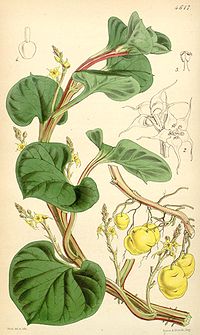
Photo from wikipedia
Manihot esculenta Crantz is originally from the Amazon region of Brazil, which has the highest genetic diversity. Due to the wide adaptation of cassava to the most diverse environments, the… Click to show full abstract
Manihot esculenta Crantz is originally from the Amazon region of Brazil, which has the highest genetic diversity. Due to the wide adaptation of cassava to the most diverse environments, the evolutionary forces acted on the crop, resulting in a more complex genetic structure. This study evaluated the population structure and the genetic diversity through 25 SSR markers of 144 sweet cassava accessions collected in seven places in the south of Brazil. All the loci analyzed were polymorphic and showed several alleles per loci with a mean of 3.36 alleles and 38 rare alleles in the population. The mean value of polymorphism information content (PIC) was 0.488, which indicates that the markers were informative and the mean observed heterozygosity was 0.644, while the mean expected heterozygosity was 0.557. The sweet cassava accessions were divided into 10 groups based on the population structure analysis. There was a moderate genetic differentiation (PhiPT = 0.106) among the sweet cassava subpopulations. The wide genetic variability among the studied accessions of sweet cassava demonstrates the importance of the emergency in the conservation of plants in germplasm banks, because the intense change in agriculture; the expansion of areas occupied by soybeans, corn, and other crops; and also the farmers’ migration from rural areas to urban areas reduced cassava cultivation over time, and as a consequence, genetic variability has been lost.
Journal Title: Plant Molecular Biology Reporter
Year Published: 2019
Link to full text (if available)
Share on Social Media: Sign Up to like & get
recommendations!